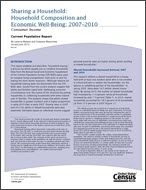Sharing a Household: Household Composition and Economic Well-Being: 2007-2010
Sharing a Household: Household Composition and Economic Well-Being: 2007-2010
Introduction1
This report analyzes and describes “household sharing,” a process by which people join or combine households. Data from the Annual Social and Economic Supplement of the Current Population Survey (CPS ASEC) were used to compare living arrangements, both prior to and following the most recent recession.2 Although reasons for household sharing were not discernible from the CPS ASEC data, results from the current analysis suggest that adults and families coped with challenging economic circumstances over the course of the recession by joining households or combining households with other individuals or families. This analysis shows that adults shared households in greater numbers and in higher proportions in early 2010 than in early 2007. Poverty rates in 2007 and 2010 for adults in shared households were also examined. Estimates based on individual income suggest personal poverty rates are higher among adults residing in shared households.3
__________
1 This report presents the results of research and analysis undertaken by U.S. Census Bureau staff. It was released to inform interested parties of ongoing research and to encourage discussion of work in progress. Any views expressed are those of the authors and not necessarily those of the U.S. Census Bureau.
2 Household sharing reflects household composition at the time of the survey. The CPS ASEC is conducted each year from February through April. The 2007 CPS ASEC was conducted before the recession began in December 2007 and the 2010 ASEC was collected after the end of the recession in June 2009. The estimates in this report are based on responses from a sample of the population. As with all surveys, estimates may vary from the actual values because of sampling variation and other factors. All comparisons made in this report have undergone statistical testing and are significant at the 90 percent confidence level unless otherwise noted. For information on confidentiality protection, sampling error, nonsampling error, and definitions, see <www.census.gov/apsd/techdoc/cps/cpsmar11.pdf>.
3 The official poverty rate is based on a comparison of total family income to a threshold based on family size and composition. For householders, personal poverty rates were derived by comparing the sum of the personal income of the householder and their spouse or cohabiting partner, if any, to the poverty threshold for a single person (if the householder had no spouse or cohabiting partner) or two people. For additional adults who were part of subfamilies, personal poverty status was calculated by comparing total subfamily income to the poverty threshold based on the size and composition of the subfamily. For additional adults who were not part of subfamilies, personal poverty status was calculated by comparing personal income to the poverty threshold for a single person ($11,344 for adults younger than 65 years in 2010; $10,458 for adults aged 65 and older in 2010).
Others in Series
Publication
Publication
Publication




